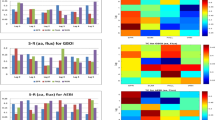Abstract
We apply Fourier and wavelet analyses to the precipitation and sunspot numbers in the time series (1901–2000) over Australia (27°S, 133°E), Canada (60°N, 95°W), Ethiopia (8°N, 38°E), Greenland (72°N, 40°W), United Kingdom (54°N, 2°W), India (20°N, 77°E), Iceland (65°N, 18°W), Japan (36°N, 138°E), United States (38°N, 97°W), South Africa (29°S, 24°E) and Russia (60°N, 100°E). Correlation analyses were also performed to find any relation among precipitation, sunspot numbers, temperature, and cloud-cover at the same spatial and temporal scale. Further correlations were also performed between precipitation with electron and proton fluence at the time interval, 1987–2006. All these parameters were considered in annual and seasonal scales. Though correlation study between precipitation and other parameters do not hint any linear relation, still the Fourier and wavelet analyses give an idea of common periodicities. The 9–11 year periodicity of sunspot numbers calculated by Fourier transform is also confirmed by wavelet transform in annual scale. Similarly, wavelet analysis for precipitation also supports the short periods at 2–5 years which is verified by Fourier transform in discontinuous time over different geographic regions.
Similar content being viewed by others
References
Bazilevskaya G A 2000 Observation of variability in cosmic rays; Space Sci. Rev. 94 25–38.
Clayton H H 1923 World weather including a discussion of the influence of solar radiations on the weather; (New York: Macmillan).
Dickinson R E 1975 Solar variability and the lower atmosphere; Bull. Am. Meteor. Soc. 56 1240–1248.
Echer Souza M P, Echer E, Nordemann D J, Rigozo N R and Prestes A 2008 Wavelet analysis of a centennial (1895–1994) southern Brazil rainfall series; Climatic Change 87 489–497.
Eddy J A 1976 The Maunder minimum; Science 192 1189–1202.
Hiremath K M and Mandi P I 2004 Influence of the solar activity on the Indian Monsoon rainfall; New Astronomy 9 651.
Hiremath K M 2006 The influence of solar activity on the rainfall over India: Cycle to cycle variations; J. Astrophys. Astr. 27 367–372.
Mitchell T D, Hulme M and New M 2002 Climate data for political areas; Area 109–112.
Mitchell T D, Carter T R, Jones P D, Hulme M and New M 2004 A comprehensive set of high resolution grids of monthly climate for Europe and the globe: The observed record (1901–2000) and 16 scenarios (2001–2100) Tyndall Centre for Climate Change Research, Working paper 55.
Mitchell T D and Jones P D 2005 An improvement method of constructing a database of monthly climate of observations and associated high resolution grids; Int. J. Climatol. 25 693–712.
Reid G C 1991 Solar total irradiance variation and the global sea surface temperature record; J. Geophys. Res. 96 2835–2844.
Reid G C 1999 Solar variability and its implication for the human environment; J. Atmos. Terr. Phys. 61 3–14.
Solanki S K and Fligge M 1999 A reconstruction of total solar irradiance since 1700; Geophys. Res. Lett. 26 2465–2468.
Svensmark H and Friis-Christensen E 1997 Variation of cosmic ray flux and global cloud coverage — a missing link in solar-climate relationships; J. Atmos. Terr. Phys. 59 1225–1232.
Svensmark H 1998 Influence of cosmic rays on Earth’s climate physics; Rev. Lett. 81 5027–5030.
Torrence C and Compo G 1998 A practical guide to wavelet analysis; Bull. Amer. Met. Soc. 79 61–78.
Usoskin G I and Kovaltsov A G 2008 Cosmic rays and climate of the Earth: Possible connection; C.R. Geosci. 340 441–450.
Verschuren D, Laird K R and Cumming B F 2000 Nature 403 410.
Xanthakis J 1973 Solar activity and precipitation; In: Solar activity and related interplanetary and terrestrial phenomena (ed.) Xanthakis J, Springer, Berlin 20.
Zhao J, Han Y B and Li Z A 2004 The effect of solar activity on the annual precipitation in the Beijing area; Chin. J. Astron. Astrophys. 4(2) 189–197.
Zhao J and Han Y B 2005 Determination of precipitation cycle in Beijing area and comparison with solar activity cycle; Earth, Moon and Planets 97 69–78.
Author information
Authors and Affiliations
Corresponding author
Rights and permissions
About this article
Cite this article
Bal, S., Bose, M. A climatological study of the relations among solar activity, galactic cosmic ray and precipitation on various regions over the globe. J Earth Syst Sci 119, 201–209 (2010). https://doi.org/10.1007/s12040-010-0015-8
Received:
Revised:
Accepted:
Published:
Issue Date:
DOI: https://doi.org/10.1007/s12040-010-0015-8




